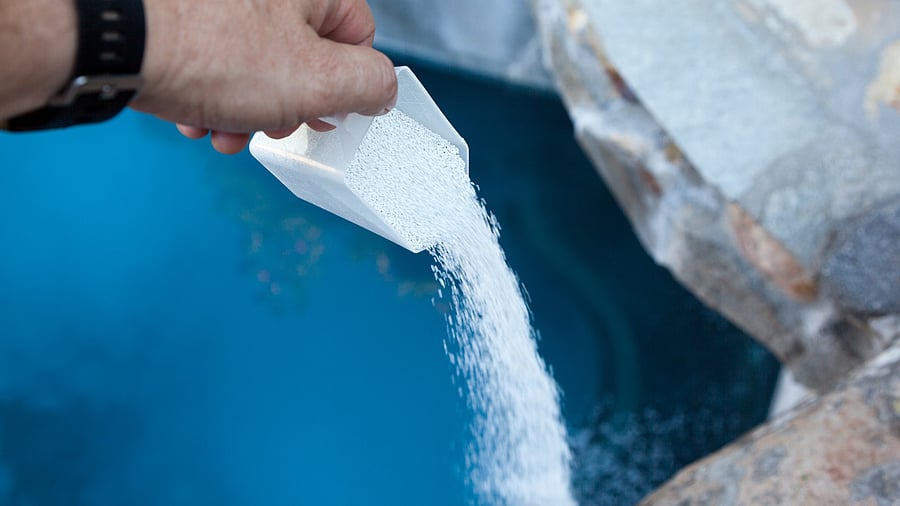
Pouring liquid chlorine into water.
Credit: iStock Photo
A study published in Environmental Health Perspective in January indicated that although chlorination prevents waterborne illness, it comes with a risk; Trihalomethanes, being a biproduct of chlorination, increases a risk of bladder and colorectal cancer even at levels below the current regulatory limits in the United States and the European Union indicating that these fail to protect against cancer in the general population.
In India, water disinfection using chlorination is a widespread practice. However, the harmful effect of the by-products of chlorination is not much talked about, particularly with disinfection byproducts like trihalomethanes (THMs). THMs are a group of chemical compounds formed as byproducts when chlorine or other disinfectants react with organic and inorganic matter in water. They include chloroform, dibromochloromethane, bromodichloromethane, and bromoform, collectively known as total trihalomethanes (TTHMs).
Recent studies link long-term THM exposure to an increased risk of cancer, particularly bladder and colorectal cancer, and reproductive disorders. THMs exposure can be through ingestion, inhalation, and while showering or swimming in chlorinated pools. Animal studies provide biological plausibility but at much higher doses than found in drinking water. However, no clinical trial has directly proven that THMs cause cancer in humans; but public health measures focus on risk reduction. Given that epidemiological data strongly suggest potential health risk linkages, regulatory frameworks worldwide have set limits on THM concentrations in potable water.
Several international agencies and national governments have established guidelines to control THMs in potable/drinking water. Key regulatory frameworks include those from the World Health Organization (WHO), the US Environmental Protection Agency (USEPA), the EU, and Health Canada. The WHO provides global drinking water quality guidelines, setting permissible limits for THMs: Chloroform: 300 μg/L; Bromoform: 100 μg/L; Dibromochloromethane: 100 μg/L; and, Bromodichloromethane: 60 μg/L.
It urges member nations to balance effective disinfection by minimising THM production. Since first mentioning THMs in its 1984 guidelines, the WHO has updated limits over the years, reflecting evolving scientific understanding of their health risks.
In eastern India, a 2015 study investigated THM concentrations in five major water treatment plants. The findings revealed high THM levels ranging from 231 to 484 μg/L, with chloroform being the predominant compound, contributing 87-98.9 per cent to total THMs. Seasonal variations indicated higher concentrations in autumn compared to other seasons. These studies underscore the importance of monitoring and regulating THM levels in drinking water to mitigate potential health risks.
In India, regulatory efforts have been drawn from the EU, USEPA, and WHO guidelines. The Bureau of Indian Standards (BIS) established permissible limits for individual THM compounds and introduced a single guideline value of 100 μg/L for all four THM compounds (IS 10500:2009). However, India faces several challenges in effectively controlling THMs in potable water sources: (a) many municipal water treatment plants lack the infrastructure to conduct consistent THM testing, leading to gaps in compliance; (b) Indian rivers and lakes, which often serve as potable water sources, often contain high levels of organic matter, increasing the potential of THM formation during chlorination; (c) while alternative disinfection methods exist, chlorination remains the most cost-effective option for Indian municipalities, contributing to higher THM levels; (d) many consumers are unaware of THM-related health risks, limiting public demand for better water treatment solutions; (e) most research on THMs is localised, focusing on specific cities, states, or regions, making it difficult to assess the nationwide prevalence of THMs; (f) comprehensive national data on THM levels are scarce, resulting in significant gaps in THM monitoring data.
Agenda for action
THMs pose a significant challenge in ensuring safe potable water globally. While international agencies have established stringent THM limits, India is gradually strengthening its policies through BIS standards, which are stricter than the WHO. To implement this, India must adopt a multipronged approach and upgrade its existing water treatment technology with an advanced system to meet the safe potable water supplies regarding THMs.
First, enhanced filtration techniques like activated carbon filtration and membrane technologies should be introduced to remove organic precursors like THMs.
Second, the chlorine dosage needs to be adjusted to the minimum levels so that THM formation is reduced in effect. Encouraging alternative disinfection methods like UV disinfection, ozonation, and chloramination will reduce chlorine formation.
Third, THM monitoring in urban and rural water supply systems, with transparent and regular reporting mechanisms, is needed.
Fourth, THM regulations must be integrated with the broader water quality management policies. Continued research and technological advancements in water treatment will play a critical role in mitigating health risks associated with THMs.
Fifth, increasing public awareness of consumers and conducting capacity building programmes for water utility staff on THM risks and best practices for water treatment is a must.
Sixth, industries and municipalities should develop the required capacity to monitor THMs in potable water/household water supply.
Adopting these measures will ensure potable water and improve public health outcomes across India.
Avanti Roy Basu is Associate Director, Mu Gamma Consultants; and S K Sarkar is Distinguished Fellow, The Energy and Resources Institute (TERI).